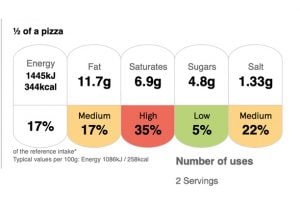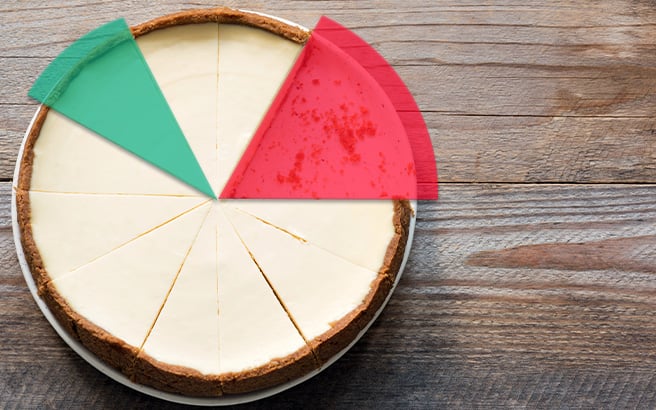In 2013, the British Heart Foundation released a report showing the shocking increase in the sizes of popular foods. Known as portion distortion, the charity revealed that servings of many ready meals, muffins and crisps had increased dramatically since 1993.
Since then, food companies have made some efforts to offer healthier portion sizes, by both reformulating the foods they produce (changing the ingredients to lower the fat, sugar and salt content) or reducing the recommended size.
 However, many people are still confused by portion sizes – or the recommended portion size is hidden away in the small print on a food label, meaning that tasty pizza you ate for supper last night was actually designed to feed 4 people.
However, many people are still confused by portion sizes – or the recommended portion size is hidden away in the small print on a food label, meaning that tasty pizza you ate for supper last night was actually designed to feed 4 people.
Another problem is that food labels showing the percentage of fat, salt, sugar and calories in a serving are based on the recommended amounts for an active adult (click here to see what the recommended amounts are, and for help reading food labels). If you’re not an adult, or not very active, the amount we should consume – and therefore the size of our portions – needs to be smaller to avoid weight gain, which is a risk factor for at least 12 different cancers.
We went shopping to look at some food products where the only healthy option is to go small or not at all.
Just a slither
Desserts such as cheescakes, trifles, sticky toffee puddings and lemon pies are one example of when a little goes a long way. One trick that supermarkets use to entice buyers is to show a slice of around 1/5 … but state in the small print that the dessert actually serves 10.
One retailer we looked at sells a 400g lemon tart to serve 6 (each 1/6th provides 222 calories, 6.1g of saturated fat and 17.g of sugar). But the same retailer sells a 475g tarte au citron, which also serves 6, bumping up the calories to 295, the saturated fat to 6.4g and the sugar to 21.2g.
One brand of pudding sold by high street supermarkets says it serves “2–4” portions. But the nutrition information is for a 1/4. So if you decide it only serves 2, a portion provides a whopping 38g of saturated fat, 914 calories and 62g of sugar!
Mindful eating
Living more healthily doesn’t mean always saying no to dessert. But getting used to smaller portions, and making your own healthy desserts at home, can significantly reduce the calories. Check out all our healthy dessert recipes.
A slice of reality
 How often, when eating out or ordering pizza for delivery, do you share the pizza with someone else? For pizzas, the nutrition information is usually based on 2 people sharing. And with pizza, size matters. For shop-bought frozen or fresh pizzas, the size can vary from 320g (around 442 calories per half pizza) to 555g (around 755 calories per half pizza).
How often, when eating out or ordering pizza for delivery, do you share the pizza with someone else? For pizzas, the nutrition information is usually based on 2 people sharing. And with pizza, size matters. For shop-bought frozen or fresh pizzas, the size can vary from 320g (around 442 calories per half pizza) to 555g (around 755 calories per half pizza).
 For pizzas sold as large (often over 600g) the recommended portion size is 1/4 (around 460 calories). So if you ate the whole thing, you’d be consuming nearly all your daily calories – in one meal! For all the shop-bought pizzas we analysed, none prominently displayed that the pizza served 2 people, although some did display nutritional information on the front of the box showing what half a pizza provides.
For pizzas sold as large (often over 600g) the recommended portion size is 1/4 (around 460 calories). So if you ate the whole thing, you’d be consuming nearly all your daily calories – in one meal! For all the shop-bought pizzas we analysed, none prominently displayed that the pizza served 2 people, although some did display nutritional information on the front of the box showing what half a pizza provides.
Top tip
Make your own pizza! If you buy frozen dough and top it yourself, you’re likely to consume far fewer calories than in a takeway pizza. Serve with a large salad for extra nutrition.
Are crisps for sharing?
 Crisps are a staple of lunch for many people. They’re often included in meal deals, and with the (sadly virtual) Museum of Crisps cataloguing more than 1,000 flavours, there’s something to suit almost everyone. According to the Leicester Mercury, Walkers, one of the UK’s most popular brands, uses 340,000 tonnes of potatoes a year.
Crisps are a staple of lunch for many people. They’re often included in meal deals, and with the (sadly virtual) Museum of Crisps cataloguing more than 1,000 flavours, there’s something to suit almost everyone. According to the Leicester Mercury, Walkers, one of the UK’s most popular brands, uses 340,000 tonnes of potatoes a year.
 But from the staple 25g bags, we’re now offered crisps on a much larger scale, including grab bags (around 50g) and share bags (around 150g) – that’s as much as in 6 “normal” bags of crisps. The problem is, when a share bag is tipped into a bowl and eaten at a BBQ or while watching the TV, they’re often shared between fewer than 6 people, or we share more than one bag.
But from the staple 25g bags, we’re now offered crisps on a much larger scale, including grab bags (around 50g) and share bags (around 150g) – that’s as much as in 6 “normal” bags of crisps. The problem is, when a share bag is tipped into a bowl and eaten at a BBQ or while watching the TV, they’re often shared between fewer than 6 people, or we share more than one bag.
Our research
Evidence in our 2018 Diet and Cancer Report revealed that greater screen time increases the risk of being overweight, partly because we’re sitting still and partly because of the higher calorie foods we’re tempted to consume.
Party bag staples
 Small bags of sweets and chocolate are a favourite in children’s party bags. However, you can’t buy individual fun-size bars – you have to buy a packet that contains between 16 and a whopping 70 bars or bags! So they’re definitely designed for sharing.
Small bags of sweets and chocolate are a favourite in children’s party bags. However, you can’t buy individual fun-size bars – you have to buy a packet that contains between 16 and a whopping 70 bars or bags! So they’re definitely designed for sharing.
Fun-size servings have been with us for decades, but now – like crisps – you can also get share bag of chocolate, also known as bite size or pouches. These bump up the volume from 20g in a share bag to nearly 270g in a share bag for some confectionery. The message is clear: many people like a sweet treat now and again, but only opt for the larger sizes if you really do plan to share them, and make them an occasional buy, not something you shop for every week.
Fun-size fact
Mini chocolate bars were originally known as junior bars! See more fun-size history here.
Can we help?
We have lots of resources to help you eat a healthy diet, which is a great way to reduce your risk of cancer. From advice on healthy portion sizes, to free booklets and healthy recipes, we’re here to support you.

